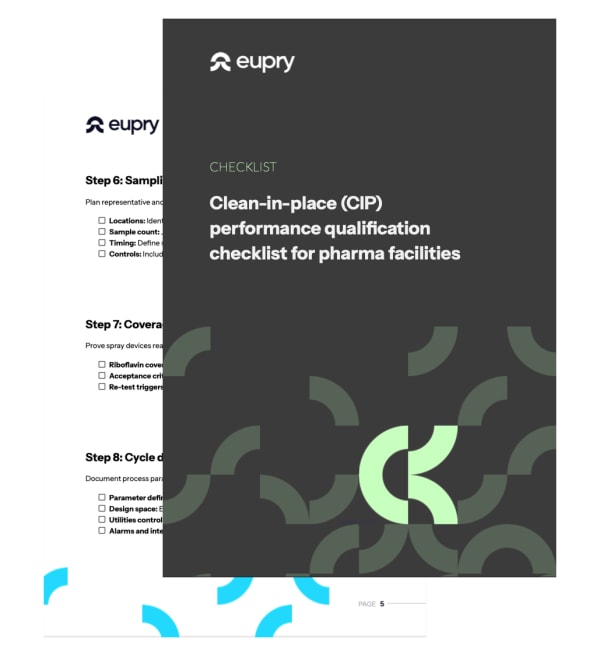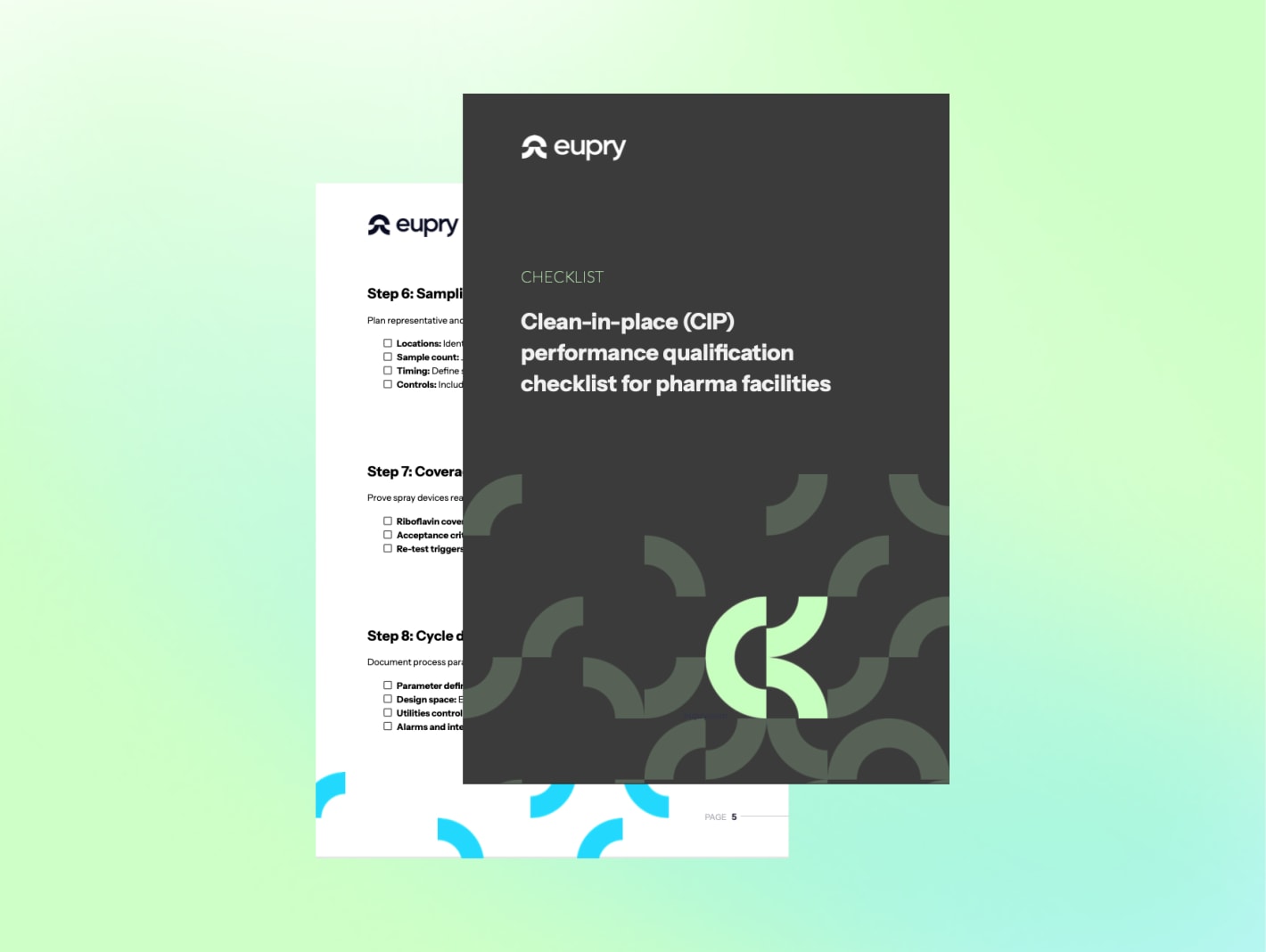How to design CIP systems for pharma and biotech?

Adam Hartmann-Kruckow
Get a step-by-step guide to designing GMP-compliant CIP systems for pharmaceutical and biotech facilities - from requirements to validation, and real-world operational best practices.
An easy‑to‑use, GxP‑aligned template covering all the steps to plan and execute CIP qualification.

Well‑designed clean‑in‑place (CIP) systems make GMP compliance repeatable across sites and product lines. This guide shows how to specify, design, and verify CIP so it reliably removes residues, supports validation, and fits real‑world operational constraints in pharmaceutical and biotech manufacturing, including multi‑product facilities and harmonized design across sites.
What does good GMP-compliant CIP design require?
A compliant CIP design integrates hygienic hardware, controllable cycles, and verifiable evidence. The goal is to prove that cleaning is effective, reproducible, and documented throughout the lifecycle, meeting EU GMP Annex 15, FDA 21 CFR Part 211, MHRA, Health Canada, and PIC/S expectations.
- Hygienic geometry: Full drainability, short flow paths, and minimal dead legs to prevent residue persistence.
- Cleanable surfaces: Proper surface finish and avoidance of crevices ensure soils do not adhere and swab recovery is achievable.
- Validated controllability: Parameters like time, temperature, flow, pressure, and concentration can be set, monitored, and trended.
- Evidence by design: Sensors and sampling points make validation and continued verification practical.
Also read: Clean in place (CIP) in pharmaceuticals and biotech: complete GMP compliance guide
How do you define user requirements and design inputs for GMP validation?
Clear, traceable requirements reduce redesign and speed validation. Capture process, quality, and operational needs early and maintain traceability through FAT/SAT to IQ/OQ/PQ.
- Process soils and products: Identify worst‑case actives and excipients, noting solubility and cleanability to inform chemistry and cycle design.
- Equipment and scope: Include all product‑contact assets (bioreactors, fermenters, tanks, lines, filters) and describe CIP connections.
- Utilities and capacity: Quantify water quality, flow, steam, and waste handling so parameters stay within ranges.
- Operational constraints: Changeover windows, batch sizes, and hold times shape cycle design—especially important for multi‑product or high‑throughput facilities.
- Data and records: Define electronic record needs with audit trail and role-based access to meet ALCOA+ and data integrity.
Also read: CIP vs SIP in pharma manufacturing: differences, GMP validation requirements, and decision criteria
How should you engineer CIP cycles for validated cleaning performance in pharma manufacturing?
Effective cycles balance chemistry, temperature, mechanical action, and time, all justified by development data.
The step structure often includes a pre‑rinse to remove gross soils, a detergent wash to dissolve residues, and final rinses to remove chemistry and particulates. Control parameters such as temperature, flow/pressure, and detergent concentration to ensure cleaning efficacy. Set endpoints for conductivity, TOC, or microbial limits based on product risk. Use interlocks so steps only start when prerequisites are met, with alarms and deviations logged.
Also read: Clean in place (CIP) in pharmaceuticals and biotech: complete GMP compliance guide
Why poor spray coverage will fail your GMP inspection
Coverage is critical-unwetted surfaces will not clean. Device selection and verification must be part of the validation package.
- Device selection: Static or rotary devices must meet minimum flow and pressure at worst‑case points.
- Positioning: Avoid nozzle shadows from baffles, probes, or dip tubes.
- Verification: Use riboflavin or similar tests; document with photos.
- Re‑testing: Required after modifications or replacements.
Also read: Complete guide to steam‑in‑place (SIP) validation in GxP
How do you manage utilities for reliable, efficient GMP cycles?
Utility stability determines cleaning repeatability. Water quality should meet pharmacopeial grade, with point‑of‑use flow and return capacity validated. Heat exchangers and recirculation loops must maintain target temperatures without overshoot. Instrumentation should be calibrated and placed to represent product-contact conditions. Optimize resource use without compromising acceptance criteria.
Also read: Continuous temperature mapping solution - how does it work?
Which materials and components meet GMP cleanability and longevity needs?
Material choices affect cleanability, maintenance, and compliance.
- Metals: Suitable surface roughness for swab recovery.
- Elastomers: Compatible with cleaning chemistry and thermal cycling; define inspection and replacement intervals.
- Valves: Hygienic designs with no dead spaces.
Also read: Designing CIP systems for regulated pharma and biotech
How do you design for instrumentation and data integrity from day one?
Designing in traceability supports efficient validation and smooth inspections. Critical parameters should be identified and recorded with set alarms. Audit trails must have role-based access and be reviewed periodically. Retention periods and backup procedures should be clearly defined.
Also read: 21 CFR Part 11 checklist
How should you verify design at FAT, SAT, and IQ/OQ?
Verification proves design intent and controllability. Factory and site tests should demonstrate control functions and interlocks. Installation and operation should involve tracing components and challenging operational ranges. Performance qualification handover should define sampling plans and worst‑case runs.

Download your CIP performance qualification checklist
A practical blueprint to help you conduct clean-in-place (CIP) qualification reliably and aligned with regulatory expectations of GMP.
Templates and further reading
- CIP performance qualification checklist for pharmaceutical facilities
- Clean in place (CIP) in pharmaceuticals and biotech: complete GMP compliance guide
- CIP vs. SIP in pharma: Differences, requirements, and decision criteria
- Complete guide to steam‑in‑place (SIP) validation in GxP
- Introduction to steam in place (SIP)

Frequently asked questions about CIP and SIP
13-steps: Clean-in-place performance qualification
Get a step‑by‑step checklist to help you conduct clean‑in‑place (CIP) qualification reliably, efficiently, and in line with GMP requirements.
